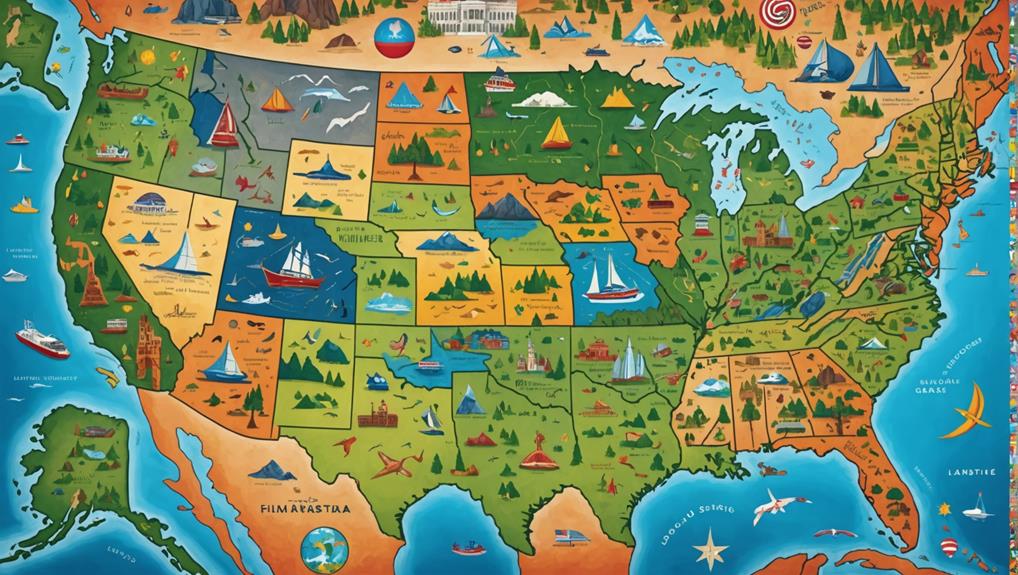United States:Uj3t4zt70_Q= Map of the United States provides an interactive and detailed representation of geographical features and political boundaries. You can easily navigate its user-friendly interface, allowing you to zoom, toggle layers, and customize the map’s appearance. Its color-coded symbols enhance understanding of various attractions. The map is accurate, ensuring that you always have the latest information at your fingertips. This tool serves multiple purposes, from urban planning to environmental studies. As you explore its capabilities further, you might discover additional insights that can deepen your understanding of the landscape.
Contents
Key Takeaways – United States:Uj3t4zt70_Q= Map
- United States:Uj3t4zt70_Q= Map offers a detailed and accurate representation of the United States, including geographical features and political boundaries.
- Users can interact with the map, zooming and toggling layers for a customized exploration experience.
- It provides data visualization tools, making complex geographical information easy to understand.
- The map is versatile for various applications, including urban planning, environmental studies, and marketing strategies.
- Unlike other mapping tools, it balances user-friendliness with advanced customization options for an enhanced learning experience.
Key Features and Benefits
One of the standout features of the Uj3t4zt70_Q= Map is its user-friendly interface, which offers seamless navigation for users of all experience levels. This intuitive design not only enhances your experience but also enables you to explore the map with ease.
Here are three key benefits that make this map an invaluable tool:
- Interactive Features: You can engage with various elements, allowing you to zoom in on specific locations, toggle layers, and access additional information effortlessly. This interactivity makes the map not just a static image but a dynamic resource.
- Data Visualization: The map excels in presenting complex data visually, transforming numbers into easily digestible graphics. Whether you’re analyzing demographic trends or environmental data, the clear visual representation aids in comprehension and decision-making.
- Customization Options: Users can tailor the map to meet their specific needs, whether that’s by adjusting color schemes or selecting different data overlays. This level of personalization guarantees that you get the most out of your mapping experience.
Together, these features enhance your understanding and exploration of geographic information, granting you the freedom to discover the world around you.
How to Use the Map
Guiding through the United States Map is straightforward and intuitive, allowing you to dive right into your exploration. To maximize your experience, start by familiarizing yourself with the map’s layout. Look for key landmarks, state borders, and major highways. This foundational knowledge enhances your navigation efficiency.
When you’re ready to plot your route, consider using color-coded symbols for different types of attractions or sites. This visual aid not only simplifies your journey but also allows you to discover hidden gems along the way. Always pay attention to map accuracy, ensuring the information reflects current conditions. Outdated data can lead to frustrations, particularly in unfamiliar areas.
As you navigate, keep these navigation tips in mind: Zoom in for detailed views of specific regions and zoom out to gain a broader perspective. If you encounter obstacles or detours, don’t hesitate to adjust your route accordingly. Flexibility is key to a fulfilling exploration. Finally, maintain an open mind; the journey often leads to unexpected destinations. Embrace these opportunities for spontaneity, and let the map guide you toward your next adventure in the vast landscape of the United States.
Unique Use Cases
The United States map serves a variety of unique use cases that extend beyond simple navigation. You can explore its creative applications in several impactful ways.
- Urban Planning: City planners utilize the map to visualize zoning laws, population density, and resource allocation, ensuring that developments align with community needs.
- Environmental Studies: Researchers employ the map to track climate change effects, wildlife migration patterns, and natural disaster impacts, providing real-world examples that inform policy decisions.
- Marketing Strategies: Businesses leverage the map for targeted advertising, identifying regional trends and consumer behavior, allowing for tailored campaigns that resonate with local audiences.
These use cases illustrate how the United States map transcends its traditional role. It becomes a powerful tool for analysis and decision-making, offering insights that can drive innovation and improve quality of life. Each application showcases the versatility of the map, affirming its relevance in various fields. By harnessing these unique use cases, you can contribute to a more informed, engaged, and free society, where data-driven decisions pave the way for progress.
Comparing With Other Mapping Tools
When evaluating the United States map alongside other mapping tools, it’s clear that various platforms offer distinct functionalities tailored to different user needs. For instance, Google’s mapping technology excels in real-time navigation and extensive database integration, providing users with a seamless experience for driving directions and local searches. In contrast, specialized tools like ArcGIS focus on advanced data analysis and geographical information systems, catering to professionals who require in-depth spatial analytics.
While exploring these options, consider how user experience varies. Some tools prioritize simplicity and ease of use, making them ideal for casual users who just want a quick overview of locations. Others, like OpenStreetMap, rely on community contributions, enhancing the map’s accuracy but potentially complicating the user interface.
Ultimately, the choice of mapping tool depends on your specific needs—whether you seek detailed geographic analysis or straightforward navigation. By understanding the strengths and weaknesses of each platform, you can select the one that best aligns with your goals, allowing for greater freedom in how you engage with mapping technology.
Conclusion – United States:Uj3t4zt70_Q= Map
In summary, the United States:Uj3t4zt70_Q= Map stands out with its stunning simplicity and stellar functionality. By seamlessly showcasing spatial data, it serves as a splendid solution for various users. Whether you’re traversing neighborhoods or analyzing analytics, its unique features enhance your experience. When compared to other mapping tools, it proves to be a powerful partner in exploration. Embrace this innovative instrument, and let it lead you on your journey of discovery through dynamic landscapes and detailed directions.

